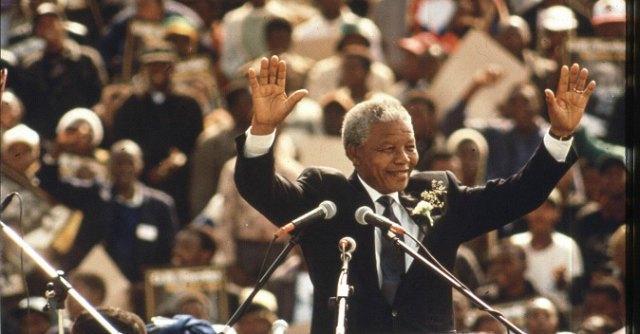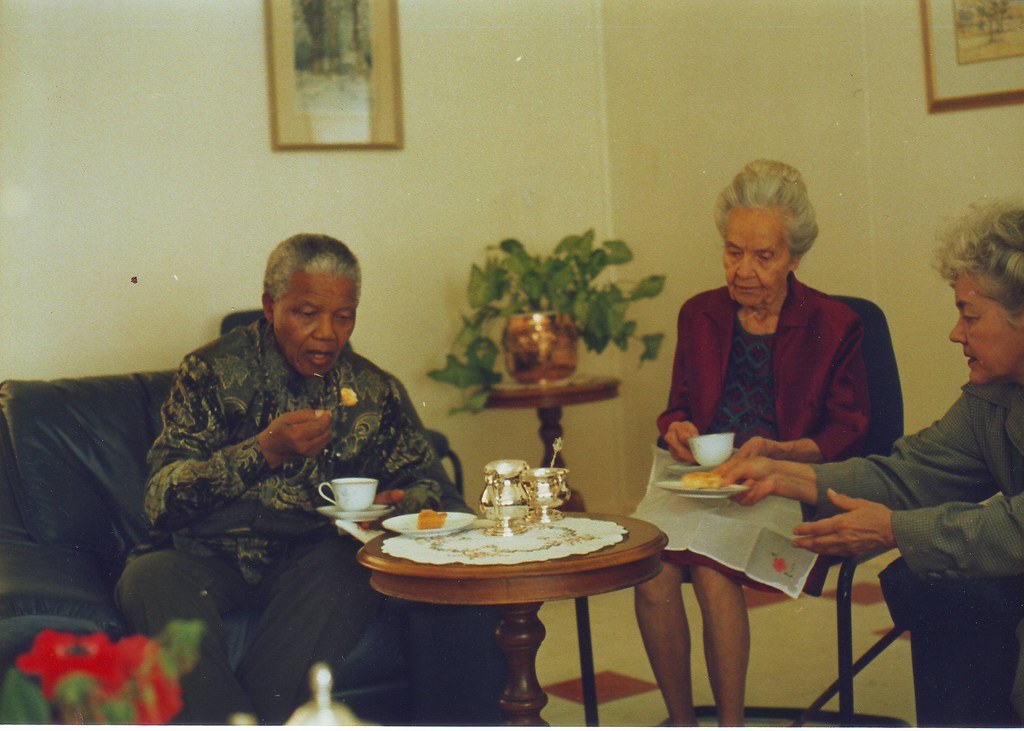Nelson Mandela remains one of the most enduring narratives Africa has produced. When he was released from Victor Verster Prison in 1990, after 27 years behind bars, the people of South Africa agitated for his instatement into power. He had been anointed by the court of public opinion as the man that would lead South Africa out of 50 years of systematic racism. A symbol of hope that not only represents South Africa’s Apartheid struggle, but also the attempted reintegration of black, white, Afrikaan, Indian and coloured people under the single umbrella that is South African.
It doesn’t end there, Mandela’s legacy also rippled abroad as Apartheid was the last identifiable relic of white oppression in the African Continent. In theory, the story is one of excellence and human restraint; but when examined further, the curtain starts to part and reality is much colder and less flattering than what is perceived.

Mandela died in 2013, yet his non racial democratic approach had started to unravel at the seams decades prior. With xenophobic attacks, sycophancy amongst the ANC and a few calculated attempts to compromise rule of law for political benefits. During this period, it seemed everything had changed. Black people pulled the strings of power, they could go places and marry interracially, yet, nothing had changed. The economic scale still tipped, unfavourably, to one side.
This is for good reason. As at 1994, the National Party (the Boers) still had a firm hold on the South African community. Although the protesters did ruffle feathers, opinions hold that the apartheid government would have effectively suppressed an insurrection. But they chose to handover power because blatant segregation had become unpopular in the modern world and persistent unrest would have made the country ungovernable and unnecessarily tense.
Since there was no proper overthrow of the apartheid regime, the fineprint for South African independence protected the oppressors. And it still serves as the bedrock for the wide economic disparity present in South Africa today. According to the World Bank, the richest 10% of the population held around 71% of net wealth in 2015, while the bottom 60% held 7% of the net wealth—the most unequal wealth distribution in the world. The class divide is widely tipped in the favour of white south Africans. Dreamlike areas like Hout Bay are a stark contrast to the slummy settlements in Imizamo Yethu. The conversation is no longer about equal rights, it has shifted to one of basic standards of living.
Drawing parallels to Mandela’s approach to integration when he became president, Zimbabwe’s Robert Mugabe finds his place at the other end of the spectrum. Although Mandela and Mugabe share similarities, being leaders of oppositions that took radical measures at some point in their separate struggles. Mandela went to prison for 27 years after being convicted for civil unrest, which involved agitation of a radical subsection of the ANC. Mugabe was also incarcerated from 1964 to 1974 for political agitation within the state. He earned two law degrees from the University of London while in prison.



Upon Mugabe’s release, he became a cultural icon in the struggle against Zimbabwean colonialism. He was elected by the African National Union to spearhead the fight for independence. When Zanu-PF (his party) won the first election in 1980, he was regarded a symbol of hope across Africa. A teacher turned freedom fighter turned Prime Minister. His story was weaved with the same sensation that followed historic men and he was not only considered a friend to the west; he was a formidable colleague. After a taste of power, Mugabe’s path diverged from Mandela’s.
In 1982, things turned sour between Mugabe and Joshua Nkomo, a fellow revolutionary who led the Zimbabwe African People’s Union (ZAPU). Nkomo had been given a ministerial position after Independence, but was ousted after being accused of planning a coup. Nkomo, however, still enjoyed support from the Ndebele people (he was from there, as well). Mugabe took aggressive measures to stifle oppositions and in 1983, gave the directives for an orchestrated ethnic cleansing.
Codenamed Gukurahundi; the rain that washes away the chaff. Mugabe’s death squad; Fifth Brigade, maimed between 20,000 to 80,000 people within Ndebele. Sometimes, forcing victims to dig their own graves before killing them. Robert Mugabe never claimed culpability till he died. Although he once referred to it as a moment of madness in 1999, after Nkomo died, and then tried to graze over the question in a 2015 interview.
Mugabe grew even more daring through his 37-year tenure, backing independence war veterans to seize white-owned farms on the logic that they were illegally occupied. This crippled Zimbabwe’s production capacity. It was a show of force that also led to the mass emigration of white people from the country. The rest as they say, is history.
Mandela’s approach on the other hand was different. His time in prison also elevated his status in the anti-apartheid struggle. When he rose to Presidency, flanked by fellow revolutionist, Thambo Mbeki—his dream for South Africa was unracial and symbolic. He chose to set aside the bitterness that had accumulated over the years to pursue the reintegration of black South Africans.
Memorable acts that portrayed a forgiving spirit were heavily publicised worldwide. The aftermath of the 1995 Rugby World Cup comes to mind—where Mandela celebrated and embraced the white Springbok team that brought the trophy home, with no mention of the lack of diversity in the line-up. He also famously had tea with Betsie Verwoerd (Widow of Hendrik Verwoerd; Chief architect of apartheid) in 1995. Mandela refused to see colour, and that might have been a major shortcoming in the new beginning South Africa enjoyed.



Mandela and Betsie Verwoerd
Mandela and the activists had struck a deal and their hands were tied by it. The black South Africans that made up the largest part of the country carried substantial generational trauma. Beyond body language and acts of benevolence, Mandela did little to pursue reparations or enforce wealth distribution. In cases of blatant racism, he turned the other cheek to pass a message. In his tenure as president, only a few landmarks witnessed a change of name. Even down to this day, some South African streets, regions, places, buildings are still named after individuals that enforced apartheid. His actions looked good on paper, but in reality, they were not enough to salve injury accrued over 50 years.
The white population of South Africa barely received a slap on the wrist after orchestrating the most audacious social experiment in history. They still kept the spoils of war, and it is no surprise that 18.6% of whites believe that Apartheid was not a crime against humanity in the 2012 Reconciliation Barometer report (Although it is worth noting that 11.6% of blacks share this sentiment).
Acts of reparation that had been proposed included a Land reform program that aimed to give back land to the blacks, with compensation accorded to the whites the land are taken from. Little progress has been made in this regard for economic reasons. It would also be foolhardy to strip white South Africans of their land just because they are white. However, it is also necessary to know how they ended up owning this land:
Since the Dutch East India Company boats hit shore in 1652, the history books have majorly been written by Europeans. The Dutch had settled on the coasts of South Africa, which they called Cape Colony. Their initial plan was to create a port where they could replenish supplies during their long-distance trips to Indonesia. Indonesia at that time, was a Dutch Colony specialised in spice production. In 1657, some workers within Cape Colony were laid off the Dutch East India Company. As part of their severance, they were allocated pieces of land to farm with, along the terrain.
When these farmers, who later became known as the Free Burghers, realised that the land was more fertile in other parts of the region, they moved inland. The Burghers were faced with resistance from the Khoikhoi people, who refused to give away their land, nor be enslaved. Sparking a conflict within the region that later ended with South African natives being dispossessed of their land. Added to the British-Dutch scuffle over the years, South Africa became a British colony in 1795, then it was returned, retaken, then returned.
South Africa’s history is heavily ladened with racial and economic complexities that sometimes raises more questions than answers. It’ll be inappropriate to strip the settlers of their heritage after 300 years. But questions involving land appropriation has continued to puzzle both the government and the South African people. Racism, colourism and classism are also issues that demand to be addressed within the society.
Mandela was slow to address the shifting landscape in South Africa, HIV/Aids being one. And when Xenophobic attacks received international attention in 2008 (there had been scattered reports since 1994), there was no statement to quell the unrest within the Mzansi community. It is quite mind boggling how South Africa can be guilty of the most unafrican actions considering their struggle for independence and the birth of a new nation. Cases of corruption amongst the ANC party has also contributed to the decay; events that Nelson Mandela refused to address while alive.
It goes to show that the new beginning the African continent celebrated in 1994 was only the start of a necessary struggle. Mandela provided Mzansi a clean slate that demanded to be built upon with decisiveness, empathy and tact. The people of South Africa needed to be educated and uplifted yet, none of these problems were addressed.
It would be unfair to push culpability solely on one person. But Mandela’s presence held South Africa in a trance. When he spoke, they listened. When he acted, they emulated. This amount of influence had the capacity to put South Africa in a better economic and social position than it stands presently. We can’t help but wonder that he could have done more. As the old axiom says, heavy is the head that wears the crown.
Unlike Mugabe, Nelson Mandela’s legacy remains intact regardless of his shortcomings. One would opine that a messiah that embodies the spirit of resilience would upset the status quo. His presence as an ideal leader would inspire the nation to set aside their differences and do more. But buried within the stratified institution of the South African populace, actions have to speak. Enemies have to be made and perpetrators need to be held accountable for their actions.
Decolonisation is a long bumpy ride. Reconciling perspectives, healing trauma, and imbibing self-worth is far more complex than one would assume. Sometimes, a symbol of hope might be the catalyst needed to aggregate social and racial divide within a community. Other times, hope is not enough. For South Africa, it isn’t.


Dr. Hannibal Lecter April 19, 2020
This was enlightening. Thank you